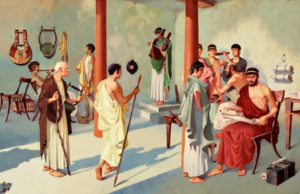
From its origins in the Homeric and the aristocratic tradition, Greek education was vastly “democratized” in the 5th century BCE, influenced by the Sophists, Plato and Isocrates. In the Hellenistic period, education in a gymnasium was considered an inextricable prerequisite for participation in the Greek culture.
There were two forms of education in ancient Greece: formal and informal. Formal education was attained through attendance to a public school or was provided by a hired tutor. Informal education was provided by an unpaid teacher, and occurred in a non-public setting. Education was an essential component of a person’s identity in ancient Greece, and the type of education a person received was based strongly in one’s social class, the culture of one’s polis, and the opinion of one’s culture on what education should include.

Athenian System
Elementary
In their early years, Athenian children were taught at home, sometimes under the guidance of a master or pedagogue. They were taught basic morals, until they began elementary education at approximately seven years of age. Children were taught how to read and write, as well as how to count and draw. Children were taught letters and then syllables, followed by words and sentences. Reading and writing were taught at the same time. Students would write using a stylus, with which they would etch onto a wax-covered board. When children were ready to begin reading whole works, they would often be given poetry to memorize and recite. An elementary education was the only education available to most people, especially the poor. Children belonging to the upper social classes would receive formal elementary education since their parents would be able to afford to hire a tutor or to send them to a public school.

Gymnasium
Having a physically fit body was extremely important to the Greeks. Greek boys would begin physical education either during or just after beginning their elementary education. In the beginning they would learn from a private teacher known as a paidotribe. Eventually, the boys would begin training at the gymnasium. Physical training was seen as necessary for improving one’s appearance, preparation for war, and good health at an old age. Traditionally, attendance at the gymnasium completed the majority of post-elementary education in Athens. It was not until about 420 BCE that secondary education became prominent, which led to controversy between traditional and modern views of education. Those of the traditional view believed that raising “intellectuals” would destroy Athenian culture and leave Athens at a disadvantage in war. On the other hand, those with a more modern view felt that while physical strength was important, it would diminish over time and that education should be used to develop the whole man, including his intellectual mind.

Secondary
After turning fourteen years old, boys from wealthy families had the option of attending secondary school. A secondary school might have been a permanent one, or it could have been received from traveling teachers such as the Sophists or other philosophers including Zeno of Elea and Anaxagoras of Clazomenae. Secondary education included subjects such as natural science (biology and chemistry), rhetoric (the art of speaking or writing effectively), geometry, astronomy and meteorology. The teaching of these subjects became highly valued within Athenian society, because the Athenians believed that intellectual education was a key component of a person’s identity, making up a significant part of a person’s reputation. Accomplishments in academics could help an individual gain the respect of his peers. With this respect, leaders such as Themistocles, Pericles, and Alcibiades were able to influence political and military endeavors pursued by Athens.
Post-Secondary
Boys could continue their education after secondary school by obtaining ephebic training. They could petition to become an ephebe at the age of eighteen. In the fifth century BCE, ephebic training began as a military education, followed by two years of military service. Later, however, more advanced academic schooling was included.

Other
As mentioned earlier, children of poor families were often unable to receive a formal education. These children, however, were not totally forgotten. Solon, an Athenian leader who lived during the 7th to mid 6th centuries BCE, did much to reform his polis, and encouraged poor fathers to provide their sons with a vocational education. By teaching these children a trade, they could also be regarded as productive members of Athenian society.
Music and dance were also very important to Athens. Throughout the many stages of an individual’s education, he was encouraged to practice dancing, singing and the playing of instruments. Common instruments used in Athens included the harp, flute and lyre. By advancing in dance, singing and the playing of instruments, an Athenian would help continue their society’s traditions.
Be the first to comment